[Notes] CSCI 585 DB Entity Relationship (ER) Modeling
21 Jan 2020 | CSCI585, English/英文, NoteCredit to: Prof. Saty Raghavachary, CSCI 585, Spring 2020
Online
- The main characteristics of entity relationship components
- How relationships between entities are defined, refined, and incorporated into the database design process
- How ERD components affect database design and implementation
- That real-world database design often requires the reconciliation of conflicting goals
Entity Relationship Model (ERM)
- Basis of an entity relationship diagram (ERD)
- ERD depicts the:
- Conceptual database as viewed by end user
- Database’s main components
- Entities
- Attributes
- Relationships
- Entity - Refers to the entity set and not to a single entity occurrence
Attributes
- Characteristics of entities
- Required attribute: Must have a value, cannot be left empty
- Optional attribute: Does not require a value, can be left empty
- Domain - Set of possible values for a given attribute
- Identifiers: One or more attributes that uniquely identify each entity instance.
An identifier is also called a KEY, or PRIMARY KEY - this is one of the ‘key’ concepts in all of database theory!! We’ll talk much more about keys later.
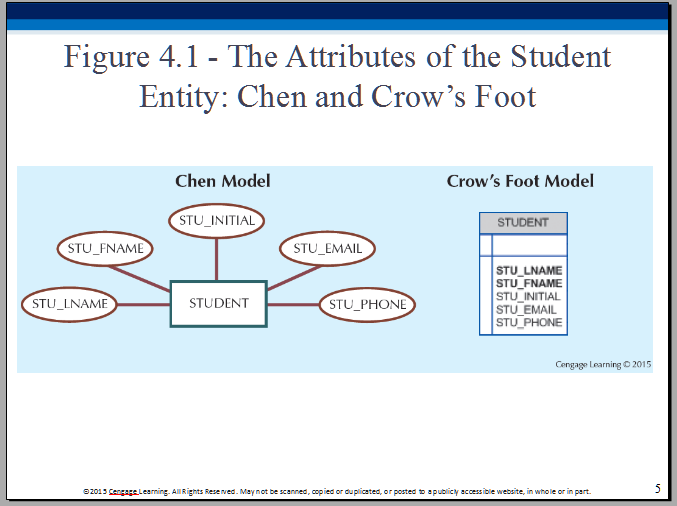
Notice: the bold attributes in crow’s foot model means required attribute
- Composite identifier: Primary key composed of more than one attribute
- Compound attribute: Attribute that can be subdivided to yield additional attributes
- Simple attribute: Attribute that cannot be subdivided
- Single-valued attribute: Attribute that has only a single value
- Multi-valued attributes: Attributes that have many values
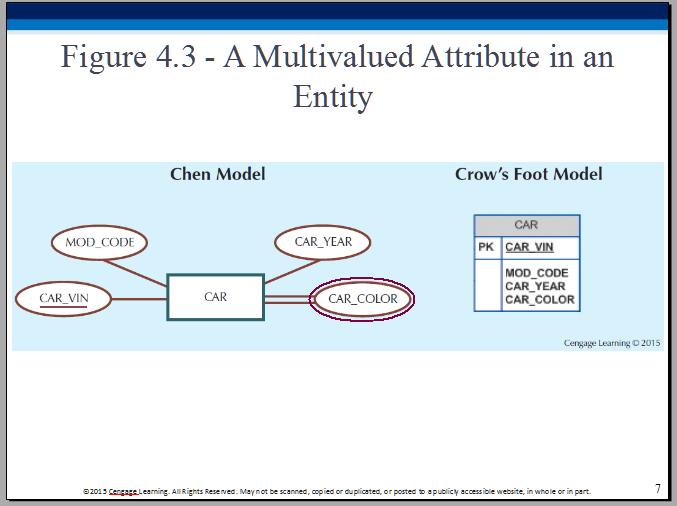
- Multi-valued attributes: Attributes that have many values and require creating:
- Several new attributes, one for each component of the original multivalued attribute
- A new entity composed of the original multivalued attribute’s components
- Derived attribute: Attribute whose value is calculated from other attributes
- Derived using an algorithm
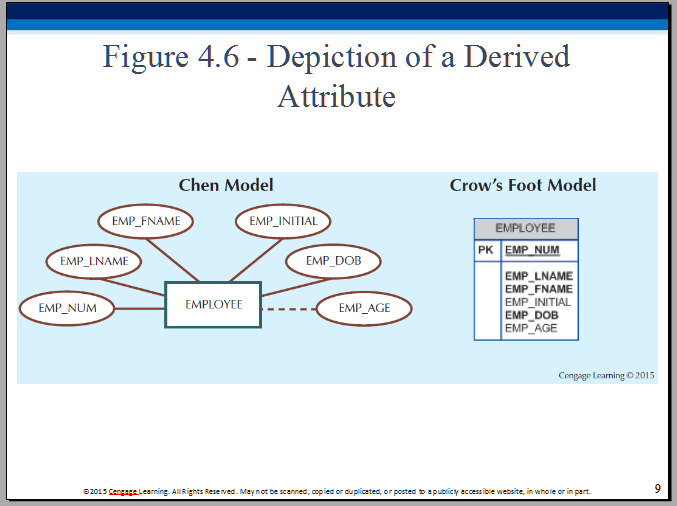
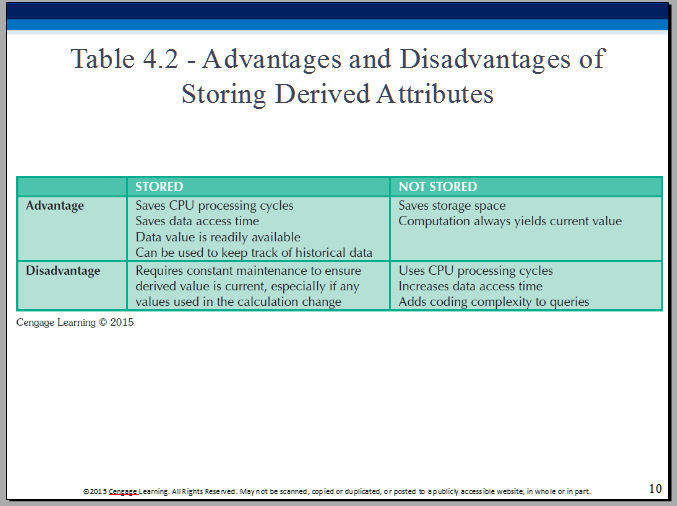
Relationships
- Association between entities that always operate in both directions
- Participants: Entities that participate in a relationship
- Connectivity: Describes the relationship classification (1:1), (1:M), (M:N)
- Cardinality: Expresses the minimum and maximum number of entity occurrences associated with one occurrence of related entity

Connectivity: 1:1, 1:M or M:N (three diff ways by which two entities are related).
Cardinality: (min,max) for 1:1, 1:M or M:N (eg. 1:1 can have (1,0) as its cardinality, 1:M can have (0,4) as its cardinality). Sometimes, min is called ‘modality’ (and max is cardinality). The ‘inside’ symbols denotes min, and the outside ones, max.
Confusingly, the # rows in a table is ALSO called table’s cardinality (and, # of columns is called the table’s degree).
Also confusingly, 1:1, 1:M, M:N are called ‘cardinality ratios’!
Existence Dependence (between tables)
- Existence dependence
- Entity exists in the data base only when it is associated with another related entity occurrence
- Existence independence
- Entity exists apart from all of its related entities
- Referred to as a strong entity or regular entity or identities entity
Existence independence implies a strong entity; but, existence dependence (alone, ie. by itself) does NOT imply a weak entity (there needs to be one more condition, based on ‘relationship strength’, for it to become ‘weak’).
An entity B is “existent dependent” on another entity A, if, a row in B can only exist when its FK is NOT NULL, ie. a corresponding entry exists in A.
Eg. if A is EMPLOYEE and B is DEPENDENT, a dependent (eg. child) in B can only exist if there is a corresponding employee (eg. Dad) in A. THIS ALONE DOES NOT MAKE ‘B’ A WEAK ENTITY!
Relationship Strength
- Weak (non-identifying) relationship
- Primary key of the related entity does not contain a primary key component of the parent entity

- Strong (identifying) relationships
- Primary key of the related entity contains a primary key component of the parent entity

Weak Entity
A weak entity needs to satisfy two conditions:
- existence dependence,
- strong (identifying/owning) relationship with a parent.
Note that a weak entity implies existence dependence, but existence dependence does not imply a weak entity!
Note weak entity $\rightarrow$ a strong (“owning” or “identifying”) relationship.
Removing the controlling (owning) entity’s key from a weak entity’s PK will result in duplicates for remaining PK(s) - THAT is what makes it ‘weak’.
- Conditions
- Existence-dependent
- Has a primary key that is partially or totally derived from parent entity in the relationship
- Database designer determines whether an entity is weak based on business rules
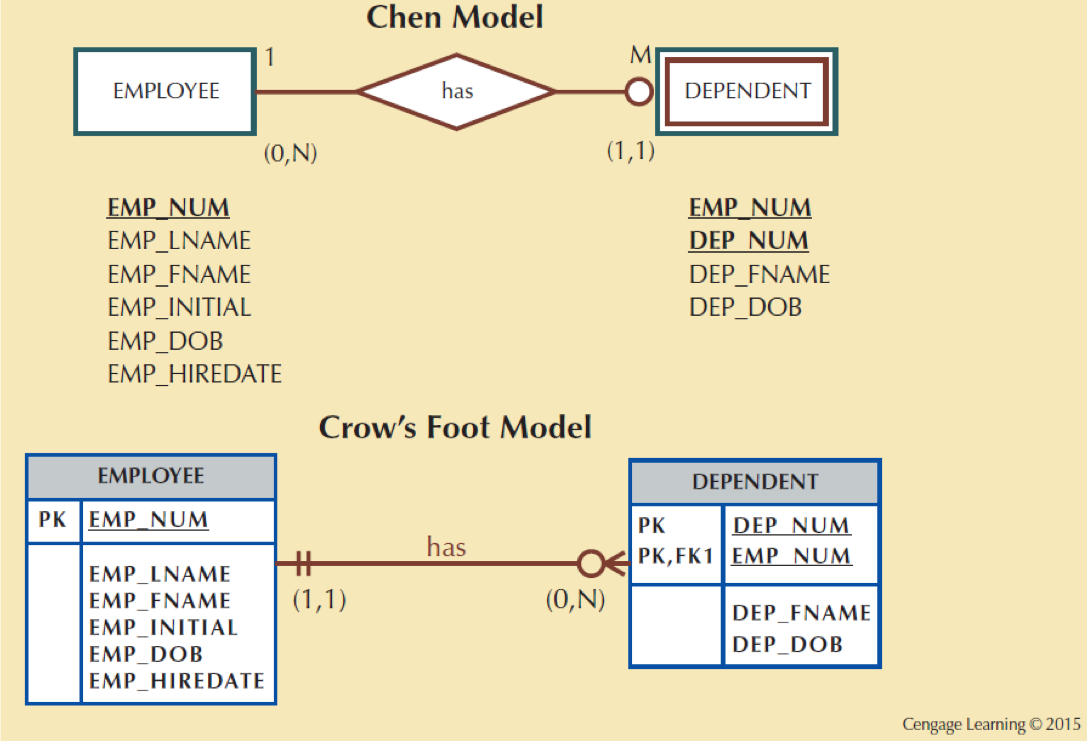

Relationship Participation
- Optional participation
- One entity occurrence does not require a corresponding entity occurrence in a particular relationship
- Mandatory participation
- One entity occurrence requires a corresponding entity occurrence in a particular relationship



Relationship Degree
- Indicates the number of entities or participants associated with a relationship
- Unary relationship: Association is maintained within a single entity
- Recursive relationship: Relationship exists between occurrences of the same entity set
- Binary relationship: Two entities are associated
- Ternary relationship: Three entities are associated


Associative Entities
- Also known as composite or bridge entities
- Used to represent an M:N relationship between two or more entities
- Is in a 1:M relationship with the parent entities
- Composed of the primary key attributes of each parent entity
- May also contain additional attributes that play no role in connective process


Developing an ER Diagram
- Create a detailed narrative of the organization’s description of operations
- Identify business rules based on the descriptions
- Identify main entities and relationships from the business rules
- Develop the initial ERD
- Identify the attributes and primary keys that adequately describe entities
- Revise and review ERD
